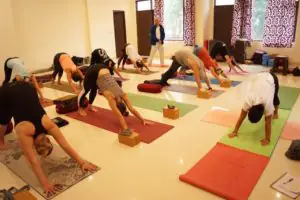We know and use most of these branches of yoga. But many eminent yoga teachers have come who started their own notable forms of yoga. They attained such mastery over yoga that they ended up making improvements and modifications to it. One such person is Bellur Krishnamachar Sundararaja Iyengar. He is better known to the world as BKS Iyengar, the creator of Iyengar yoga Centre.
What Inspired the Creation of Iyengar Yoga Centre
Three very important events influenced BKS Iyengar to create the form of Iyengar yoga. All three of these incidents throw light on the principles followed in Iyengar yoga Institute.
The first is Iyengar’s years as a trainee in yoga. His guru was another famous yoga teacher, T Krishnamacharya, credited with the globalisation of Ashtanga Vinyasa yoga. Krishnamacharya was also the brother-in-law of Iyengar. He was an extremely strict teacher. He put immense importance on getting the asanas right. The Ashtanga Vinyasa form of yoga itself requires the strict following of rules. This shaped the views of Iyengar, who incorporated it into Iyengar yoga. This is apparent as the principle that one must achieve an asana even if it requires props.
The next incident is one that had a particularly deep impact on Iyengar. As a teenager, when Krishnamacharya was teaching him a forward fold, he could not stretch far enough. So his guru climbed onto his back to make him achieve the pose. In the process, Iyengar tore a hamstring. This was a painful experience for him. When he created Iyengar yoga, he propagated the use of props to bypass such painful exertions.
The last and main inspiration behind the creation of Iyengar yoga centre was a scooter accident Iyengar was in. The accident left him with a severely injured spine that prevented him from being able to exert himself as much as he used to. So, he started looking for solutions so he could resume yoga. He found out that even ancient yogis used to make use of trees, rocks and other objects to support their bodies during a difficult pose. It inspired him to develop a form of yoga that used similar support to help disabled students, those with less flexibility or injuries.
How is Iyengar Yoga Taught
The main aspect of Iyengar yoga is the use of props. These could be anything like pillows, mattresses, chairs, stools, blocks, blankets, ropes and so on. Basically one can use any commonly used object. If a person cannot achieve the pose unaided, then the teacher will explore various props with them to see which suits them best in attaining the required posture. Gradually, as the person becomes more flexible, the teacher will reduce and finally remove the support.
The main principle behind Iyengar yoga centre is that it does not allow reaching a pose gradually. A student must reach it at once, even if it requires props. The logic is simple. Many forms of yoga allow a student to learn the accurate asana by going from the initial posture they can hold without discomfort or strain to the full-fledged asana through increasingly closer poses. This can cause a student to pick up one of these intermediate poses, which may not be the correct form. Moreover, the student will not truly experience the benefits of the pose until they get to it.
Benefits of Asana
But since Iyengar yoga encourages the pose in its correct form right from the beginning, these issues do not arise. The person enjoys the benefits from the asana from day one and neither do they learn a wrong way to do the pose. The use of props is also safer than the gradual fitting of the body to an asana. Until you reach peak flexibility, you can always exert too much or worse, fall down awkwardly from a balanced position. These are the recipes for accidents of the kind Iyengar himself experienced with his hamstring. Having support means that even in the fully folded state, something is holding you up and preventing unwarranted falls or stretches.
What Does an Iyengar Yoga Course Include
A full Iyengar yoga is quite tough if you join a class that strictly follows the Iyengar process. You must have at least three years of standard training in Iyengar yoga centre to be eligible to join the Iyengar yoga teacher training course. The first certification level in the course is the Introductory Level I. You can give the exam for this level only after a minimum of one year of training. After another year of training after the Level I exam, you can give the Introductory Level II exam.
If you pass this level, you become qualified to teach Iyengar yoga to a class. There are four more levels you can give to become more and more qualified as a teacher. These are the Junior Intermediate Level (I, II, III), the Senior Intermediate Level (I, II, III), the Junior Advanced Level (I, II, III) and the Senior Advanced Level (I, II). You must attain at least a year and a half of training between each level. Three classes are mandated per week and the teachers will assess your eligibility for the next level depending on the expertise achieved so far.
Iyengar Yoga Centre in India
There is no dearth of Iyengar yoga Institute. But you will want a school with global recognition, assured quality of courses and hundreds of positive reviews. In that case, Mahi Yoga is where you must come for the best training in Iyengar yoga Centre.

